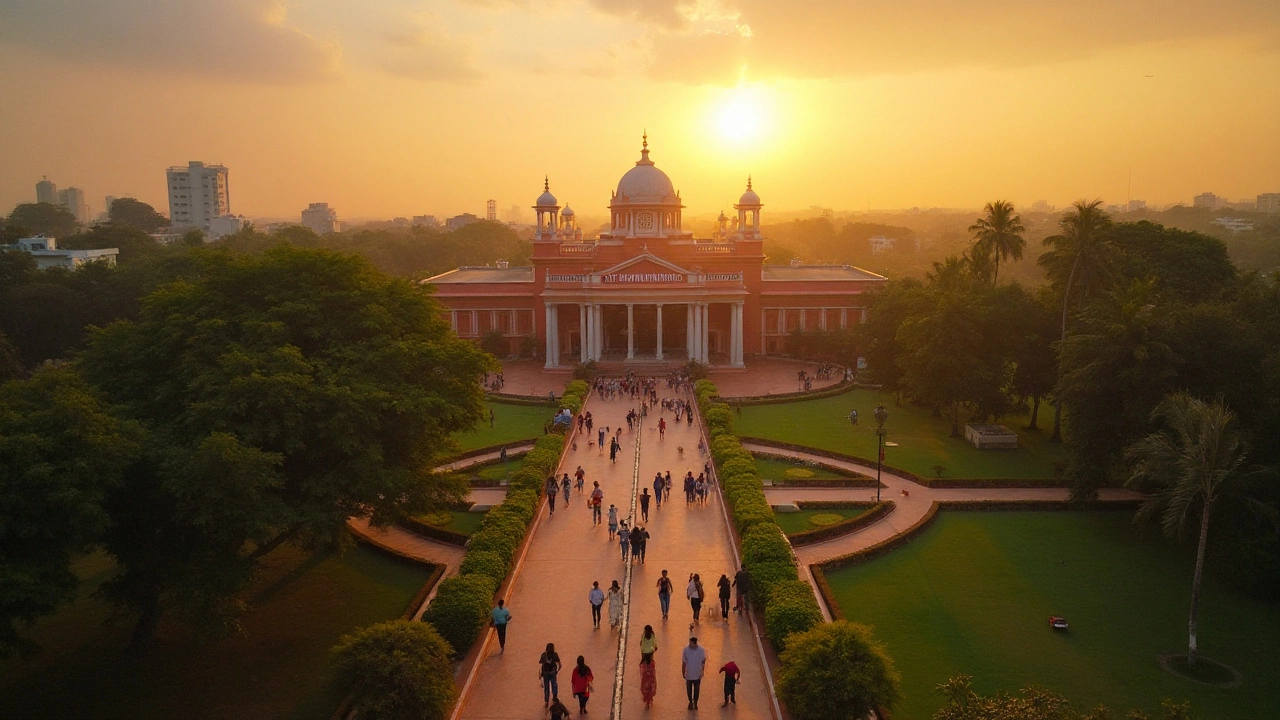The Indian Institutes of Technology, especially IIT Bombay, hold a prestigious place in the hearts of engineering aspirants across the globe. Securing a seat there is often a dream come true, but the competition is undeniably fierce. If you're eyeing IIT Bombay with a rank around 5000 in the JEE, you might be wondering about your chances.
First up, each year holds a distinct competitive landscape, with cut-offs varying based on several factors. It's crucial to analyze previous years' data to get a clearer picture. While some of the more popular branches may be out of immediate reach, newer courses or dual degree options might present viable opportunities.
Reservation policies play a critical role too. Categories like OBC, SC, and ST often see different cut-offs, which can open more doors. Alongside understanding these nuances, planning a strong strategy is essential. This includes focusing on the right courses and remaining persistent through counseling rounds. Lastly, having a well-considered backup plan can ease the journey, ensuring you're not stranded if things don't go as hoped. Remember, resilience and adaptability can carve a path to success.
- Understanding IIT Bombay Cut-Off Trends
- Courses Available for Ranks Near 5000
- Reservation Benefits and Their Impact
- Enhancing Admission Chances with Strategy
- Preparing Backup Plans and Alternatives
Understanding IIT Bombay Cut-Off Trends
Cracking the code of cut-off trends is like unraveling a fascinating puzzle, particularly when it comes to aspirants gunning for a spot at IIT Bombay. Every year, as the results of the Joint Entrance Examination (JEE) are announced, hopefuls across the country eagerly analyze the numbers that determine their fate. For those eyeing this top-notch institution with a rank around 5000, understanding the cut-off patterns is an essential step. IIT Bombay's reputation as a premier engineering school is well-deserved, and with great reputation comes high demand, making the seats here highly coveted.
Analyzing past years' data is a must when evaluating your chances. A closer look at the statistics from the last five years paints a dynamic picture. Typically, the cut-off ranks for popular courses like Computer Science and Electronics can soar, often requiring a rank much under 500. However, not every course demands such stratospheric rankings. For instance, emerging disciplines or certain interdisciplinary programs may have somewhat relaxed cut-offs, which could align closer to a rank of 5000. In 2022, for example, some specialized disciplines reported cut-offs in the mid-thousands, providing a beacon of hope for many aspirants.
The cut-off is not a mere arbitrary number but a reflection of several factors—demand for the course, number of applicants, and the overall performance in the JEE that year. Notably, rank movements between different rounds of counseling can also play a strategic role. Initially, the cut-offs might be higher, but as seats shuffle due to acceptance and rejections, ranks sometimes dip to more realistic levels for those in higher thousands. Keeping an eagle eye on these trends during counseling rounds can be a game-changer.
An insightful quote from the former IIT Admissions Director, Anil Kumar, highlights the importance of adaptability:
"In this competitive landscape, adaptability is your best friend. The trends are never cast in stone—they're as flowing as the innovation in technology itself."This adaptability is crucial as it helps students to strategize and pivot as necessary during the application process.
It's also imperative to recognize the difference that category-specific cut-offs bring to the table. General category cut-offs might be stringent, but reserved categories have their set parameters, potentially spreading opportunities more evenly among diverse socioeconomic backgrounds. The reservation policies for OBC, SC, ST, and economically weaker sections can considerably influence the cut-offs. A detailed look into 2023 data, for instance, showed a noticeable trend where reserved seats remained available for longer periods into the counseling rounds, providing a significant advantage.
To sum up, the journey through cut-off trends isn’t just about numbers—it’s an exploration of opportunities and an exercise in strategic mind-mapping. For those determined to enter IIT Bombay, monitoring these trends closely will provide a road map that can guide their dreams to reality. Familiarizing yourself with cut-off trends allows for an informed decision-making process, ensuring aspirants are fully equipped to seize every opportunity that arises.
Courses Available for Ranks Near 5000
Delving into the possibility of joining IIT Bombay with a 5000 rank, you might feel the odds are stacked against you. However, the key to this challenge lies in understanding the diverse courses the institution offers, some of which may not demand the typically sky-high ranks. With this rank, while the sought-after core branches like Computer Science or Electrical Engineering might be elusive, several other enticing options could open up.
IIT Bombay offers a plethora of courses, and while initial preferences usually center around the top-tier branches, students often find rewarding prospects in other emerging fields. For instance, less talked about courses such as Environmental Science and Engineering, Aerospace Engineering, or even newer interdisciplinary programs could likely be more accessible. The nature of these fields is compelling, engaging students with a broader perspective, allowing them to delve into realms that merge traditional engineering with contemporary issues.
"In recent years, we've seen an increased interest in interdisciplinary courses that tackle real-world challenges," noted Dr. Krishna Sharma, a faculty member at IIT Bombay, highlighting the evolving academic landscape.
Moreover, dual degree options can be a strategic consideration for many aspirants. These programs, which combine a bachelor's and master's degree, often have a different admission threshold compared to standalone bachelor's courses. This path, while it might extend the duration of study, offers a deeper educational experience and can improve job prospects upon graduation. It allows students to blend various interests, potentially setting them apart in an ever-competitive job market.
Interestingly, a closer look at the admission trends over the years will reveal that some newfound courses gain popularity and prestige gradually, making them a wiser choice for many students who prioritize passion over peer pressure. It's crucial to not just fixate on traditional notions but also to consider where industries are heading and which courses might better align with future demands. STEM fields are rapidly shifting, and IIT Bombay’s commitment to pioneering research and the development of new domains ensures that its graduates remain at the forefront of innovation.

Reservation Benefits and Their Impact
The reservation benefits provided in Indian educational institutes like IITs have a profound impact on the admission landscape. They aim to level the playing field by offering opportunities to students from various underrepresented backgrounds, ensuring that the diverse social fabric of India reflects within its premier institutions. These benefits are extended to categories such as SC, ST, OBC, and also, to a limited extent, for EWS (Economically Weaker Sections).
For a student holding a rank 5000 in JEE Advanced aiming for IIT Bombay, understanding the nuances of these reservations can be pivotal. Reserved category students often find that their effective ranks, when considered within their specific categories, improve significantly due to the specialized quota provisions. For instance, a rank that might not secure Chemical Engineering under the general category could indeed be potent for the same course for a reserved seat.
It's important to reiterate how these reservations are not just mere numbers but are rooted in historical and socio-economic contexts meant to uplift marginalized communities. The difference this makes is not trivial and can often mean the difference between securing a seat in an IIT versus missing out. As per the data from recent years, around 15% of seats in IITs are reserved for SC candidates, 7.5% are allocated to ST candidates, and 27% are earmarked for OBC candidates.
According to public policy expert Dr. Sandeep Mallik, "Reservation isn't just about creating opportunities; it's about rectifying historical disparities to create a holistic educational environment."
Moreover, for the aspiring IIT JEE candidates, being aware of the documentation and criteria necessary to avail these benefits is crucial. The administration is strict about category proofs, and any discrepancies can lead to loss of the reserved seat advantage. It's often advised for students to attend workshops or consult counseling sessions that preparatory institutions conduct, to better understand the admission processes and how best to leverage reservation benefits.
Thus, reservation benefits, when utilized effectively, leave an indelible impact on securing admissions at esteemed places like IIT Bombay. They are not just instruments of social justice but also form critical strategies in a student's journey through the competitive world of IIT entrance.
Enhancing Admission Chances with Strategy
Cracking the code to gain admission into IIT Bombay with a rank of around 5000 requires a blend of smart strategies, adaptability, and a pinch of optimism. One of the primary steps is to thoroughly analyze your options. Begin by scrutinizing past year trends atop the different courses, keeping an eye on those that align with your interests. Not every branch fills up as rapidly, so identifying less common programs or newer branches can open unexpected doors.
Optimizing your admission chances involves participating in every phase of the IIT JEE counseling process. Often, aspirants overlook the importance of successive rounds, during which quite a few students tend to upgrade to their preferred branches, freeing spots in other sought-after programs. Keeping in mind the vast number of students at the brink of similar ranks, a proactive and patient approach through all rounds can yield desirable results.
An insightful strategy invariably involves networking with seniors and professionals who have treaded the same path. They offer first-hand experiences and might provide insights into the nuances of particular courses or the value of dual degree programs. This advice can be particularly pertinent when considering investment in emerging engineering fields or interdisciplinary programs that might cater to both your skills and rank.
"Every expert was once a beginner. Don't wait; take that first step and create your future," says Dr. Rajeev Kumar, a revered professor at IIT Bombay, emphasizing the importance of courage and timely action.
Another pivotal aspect is understanding the importance of reservations and how they might impact your prospects. For students who belong to the reserved categories, scrutiny of specific category quotas and seats available under them can fundamentally alter choices. This, coupled with courses that offer integrated masters or dual degree options, might provide leeway to negotiate a spot that could be filled differently in the general category.
Consideration of test scores, while primarily foundational to qualifying, are just part of the canvas. Presenting your score strategically by applying to courses where the relative cut-off scores align closely with your result increases the likelihood of securing a seat.
IIT Bombay boasts an array of inclusive programs designed for multifaceted engineering learning, so assessing options across various courses, including beyond traditional engineering domains, should be a cardinal direction for anyone pragmatic about the journey post rank assessment. Remember, adaptability and strategic cognition turn hurdles into opportunities in the marathon that is IIT admissions.
Utilizing Reservations and Specific Criteria
Acquainting oneself with the reservation system in India could be a game-changer. The JEE system allocates certain percentages of seats for various social categories, including SC, ST, OBC, and EWS categories. Awareness of where your credentials stand within these frameworks can greatly affect your strategy. Each category has its own set of relaxed academic requirements for admission, and these can vary significantly from year to year.

Preparing Backup Plans and Alternatives
Contemplating alternatives and forging a robust backup plan is a sensible approach when reaching for a coveted spot in IIT Bombay, particularly with a rank hovering around 5000 in the IIT JEE. This section delves into devising strategies that can ease the pressure and ensure you're prepared for any outcome. Firstly, it’s important to realize the sheer competitiveness of gaining admission to India’s premier institutes means it’s prudent to have a diversified approach.
One effective methodology is exploring other IITs and reputable government institutes. While your primary aim might be IIT Bombay, it’s worth investigating other IITs where similar courses might be available with slightly more lenient cut-offs. Institutes like IIT Roorkee, IIT Guwahati, and others offer excellent faculty and resources. The quality of education in these IITs remains world-class, often making them indistinguishable in terms of the opportunities they afford their graduates. It's fascinating to note that some extraordinary technological breakthroughs and successful startups have emerged from these other IITs. This goes to show that the environment and network you find yourself in can be as influential as the location itself.
Additionally, don’t overlook NITs (National Institutes of Technology) and IIITs (Indian Institutes of Information Technology). These institutions have consistently produced top-notch professionals and offer a range of programs that are at par with IIT standards. A thoughtful application to these institutes can secure your pathway to a successful engineering career, even if it differs from your original plan. Attend their counseling sessions, keep abreast of their timings, and be ready to move quickly to seize opportunities as they arise. It’s a sensible way to hedge against the unpredictability inherent in competitive admissions.
Moreover, private engineering colleges like BITS Pilani and VIT Vellore have carved a niche for themselves with their modern infrastructure and innovative curricula. They often offer diverse course options that allow students to delve into emerging engineering fields. Despite being private institutions, they've maintained an enviable record both in terms of academic excellence and in placements in prestigious companies worldwide. Keeping these alternatives in sight often provides more peace of mind than a solitary focus on the most aspirational bastions.
While on this journey, also consider global avenues. Universities in the US, UK, and Australia, such as MIT, Stanford, or even Sydney University, offer scholarships and programs that are comparable in quality. A global education might just open unexpected doors and broaden your horizons in terms of international exposure and opportunities in an interconnected world. As you assess these options, keep financial implications, scholarship opportunities, and long-term career goals in mind. Your decision should be a balance of aspiration, practical judgment, and what aligns with your personal ambitions and dreams.
In the words of Albert Einstein:
"In the middle of difficulty lies opportunity."Remember that having a plan B isn't giving up on plan A; it's ensuring you reach your desired destination even if the route changes. Whether you end up at IIT Bombay, a different IIT, or an equally prestigious institution, what's most important is having the drive and tenacity to make the most of whichever stage you land on. The world is your oyster, and diverse educational paths can all lead to successful outcomes.

